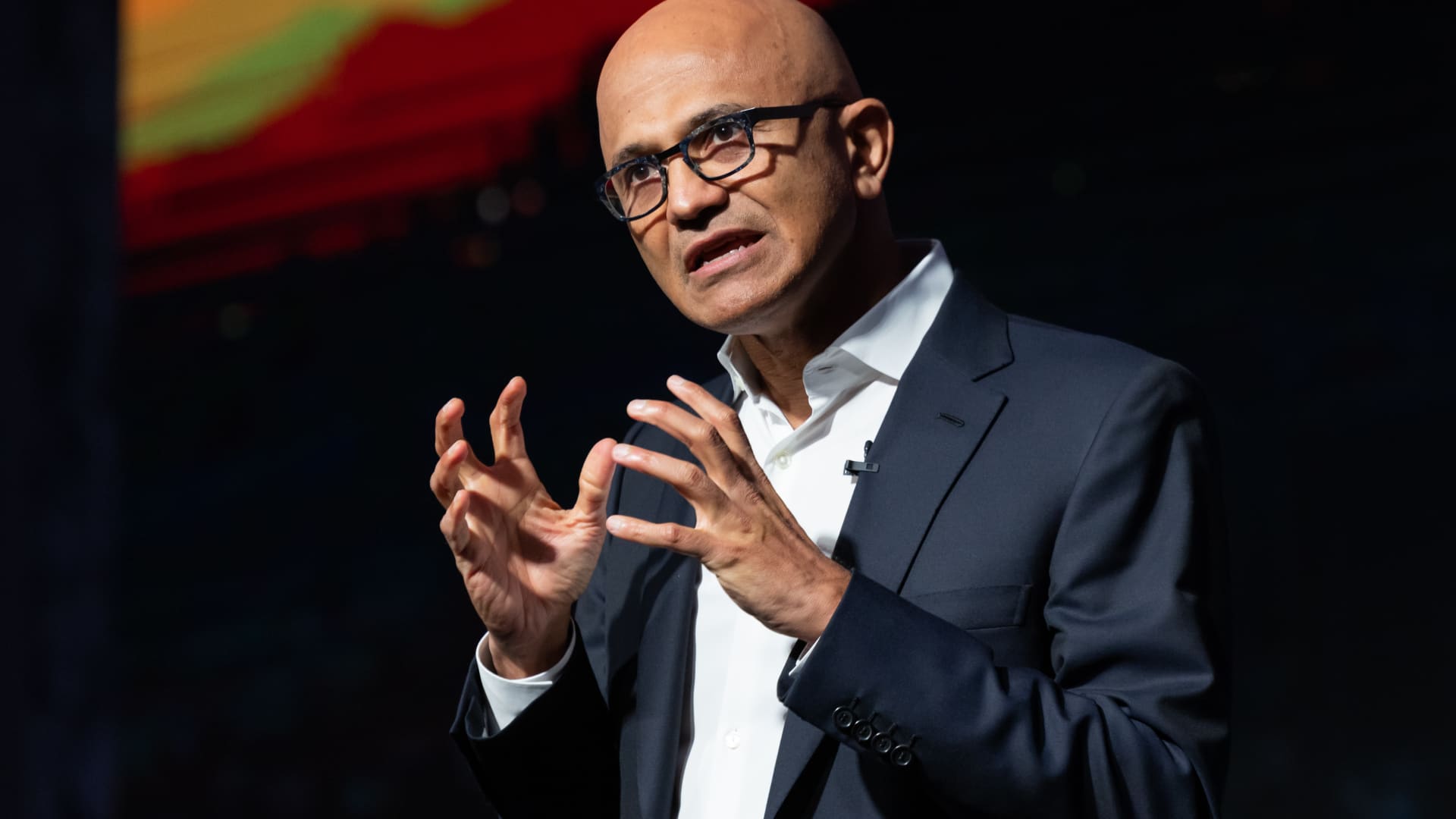
Microsoft shares slipped as much as 4% in extended trading on Tuesday after the software maker issued quarterly revenue guidance that fell short of analysts’ expectations.
Here’s how the company did:
- Earnings: $2.69 per share, vs. $2.55 per share as expected by Refinitiv.
- Revenue: $56.19 billion, vs. $55.47 billion as expected by Refinitiv.
related investing news


On a conference call with analysts, Amy Hood, Microsoft’s finance chief, called for $53.8 billion to $54.8 billion in fiscal first-quarter revenue. The middle of that range, at $54.30 billion, implies 8% growth, and falls short of the $54.94 billion consensus among analysts polled by Refinitiv. The operating segment featuring the Windows operating system came up short, with Hood seeing $12.5 billion to $12.9 billion in revenue, below the $13.22 billion that analysts polled by StreetAccount had been looking for.
Revenue rose 8% year over year in the fiscal fourth quarter, which ended on June 30, according to a statement. Growth has come in under 10% for three consecutive quarters for the first time since 2017. Net income totaled $20.08 billion, up from $16.74 billion, or $2.23 per share, in the year-ago quarter.
Microsoft’s Intelligent Cloud segment contributed $23.99 billion in revenue, up 15% and above the $23.79 billion consensus of analysts surveyed by StreetAccount. The unit comprises the Azure public cloud, SQL Server, Windows Server, Visual Studio, Nuance, GitHub and enterprise services.
Azure revenue grew 26% during the quarter, faster than the 27% growth in the previous quarter and 40% in the year-ago quarter. Analysts polled by CNBC and by StreetAccount had expected 25% growth from Azure, which competes with Amazon Web Services and Google Cloud Platform.
Microsoft doesn’t report quarterly Azure revenue in dollars. But on a conference call with analysts, Microsoft CEO Satya Nadella said “the Microsoft Cloud surpassed $110 billion in annual revenue, up 27% in constant currency, with Azure all up accounting for more than 50% of total for the first time.”
Google parent Alphabet said Tuesday that revenue from its cloud products, which includes Google Workspace productivity apps in addition to Google Cloud Platform, increased by 28%.
Prompted by concerns about a worsening economy, organizations using cloud services from Microsoft, Amazon and Google have taken time to adjust their existing workloads to reduce costs in the past several months.
“As expected in Azure, we saw a continuation of the optimization and new workload trends from the prior quarter,” Hood said on the call.
With the more careful cloud spending, the three prominent U.S. cloud providers have trimmed their own expenses.
For the first time since 2016, Microsoft’s research and development costs declined year over year. In May Nadella told employees that the company won’t lift salaries this year. And on July 10 Nadella issued a memo about a fresh round of job cuts separate from the round of layoffs affecting 10,000 workers that kicked off in January.
Microsoft’s Productivity and Business Processes segment that contains Office productivity software, LinkedIn and Dynamics delivered $18.29 billion in revenue, up 10% and more than the StreetAccount consensus of $18.06 billion.
The company’s More Personal Computing business, which contains Windows, devices, gaming and search advertising, posted $13.91 billion in revenue. That figure indicates a decline of about 4%, yet it still topped the $13.58 billion StreetAccount consensus.
Sales of Windows licenses to device makers decreased by 12%, better than management had expected, Hood said. Consumers and companies rushed to buy PCs after the onset of Covid, making comparisons difficult for the past year. Technology industry researcher Gartner estimated that PC shipments, including Apple’s MacBooks, fell about 17% during the quarter.
Microsoft and Alphabet kicked off earnings season for the mega-cap tech companies. Investors will be looking at the big tech companies for updates on cost-cutting measures implemented earlier in the year and the impact of artificial intelligence investments on profitability. Alphabet on Tuesday surpassed estimates, lifting the stock in after-hours trading. Meta reports results on Wednesday, followed by Amazon and Apple next week.
Investors are eager for resolution in Microsoft’s arrangement to buy Activision Blizzard for almost $69 billion, which was agreed upon in January 2022. Earlier this month, an appeals court denied the Federal Trade Commission’s motion to stop the transaction. Activision shares have climbed past $92.50, close to the $95 that Microsoft agreed to pay, reflecting optimism that the deal is on track to close.
The company said its operating expenses rose about 2% in the quarter, partly because of a charge to pay a fine from Ireland’s Data Protection Commission after the authority looked at whether the company’s LinkedIn unit violated the European Union’s General Data Protection Regulation.
During the quarter, Microsoft built on its broad alliance with OpenAI to capitalize on fresh interest in artificial intelligence, following the November launch of the startup’s ChatGPT chatbot. Microsoft introduced a chatbot powered partly by OpenAI language models to help workers make sense of their employers’ data, and it told developers they’ll be able to build plugins that people can access through ChatGPT, the Bing search engine’s chatbot, and other tools.
Microsoft’s Azure OpenAI Service that companies can use to access language models and other developer tools now has over 11,000 customers, up from over 4,500 in May, Nadella said.
Hood said that as Microsoft invests to meet rising demand for AI services, the company should see more impact from higher revenue from them in the second half of the 2024 fiscal year than in the first half.
“Even with strong demand and a leadership position, growth from our AI services will be gradual as Azure AI scales and our Copilots reach general availability dates,” she said. Microsoft has not said when the Copilot assistant for its Microsoft 365 productivity applications will become available for any customer to buy. Those capabilities will cost $30 per person per month in addition to existing subscriptions to Microsoft 365, the company said last week.
Microsoft’s Azure growth should be 25% to 26% in constant currency in the fiscal first quarter, with 2 percentage points deriving from AI services, Hood said, compared with 1 point in the fiscal fourth quarter.
Excluding the after-hours move, Microsoft shares have gained 46% year to date, while the S&P 500 is up 19%.
— CNBC’s Todd Haselton contributed to this report.






